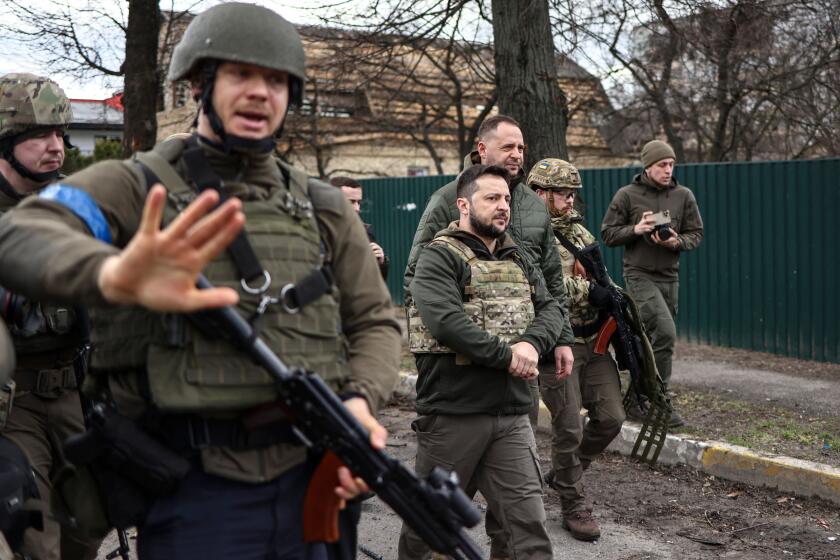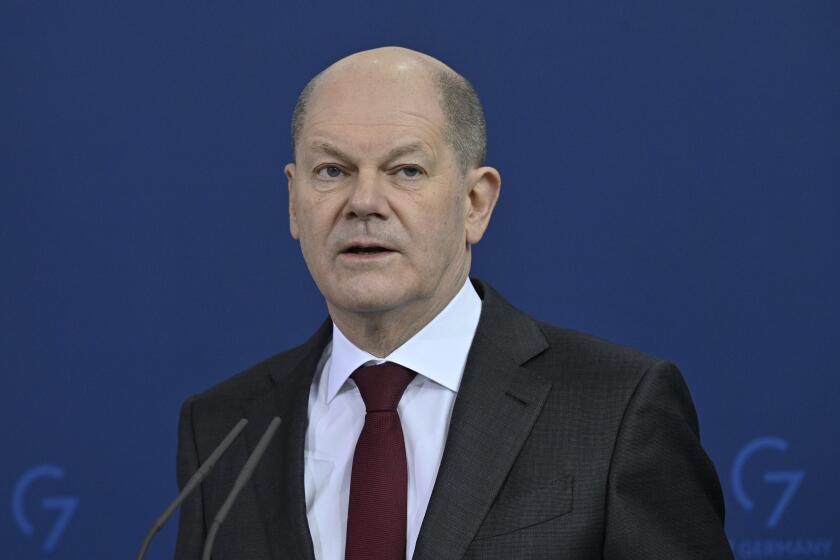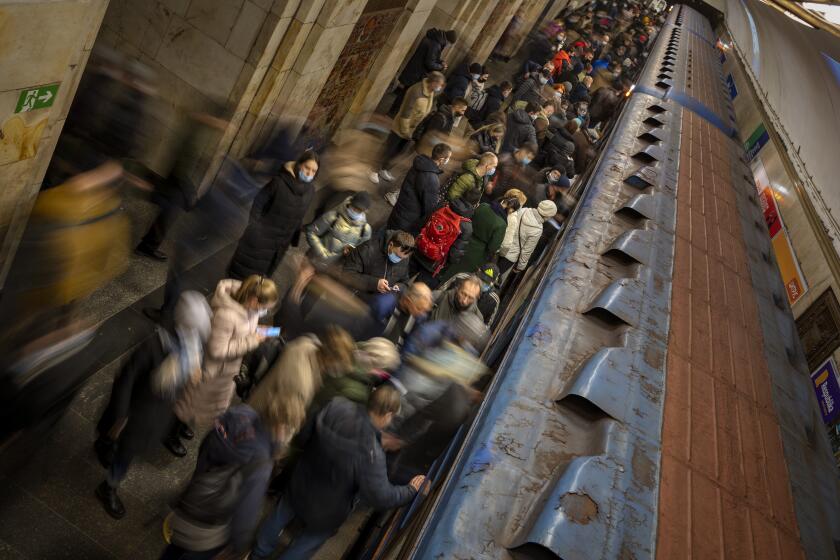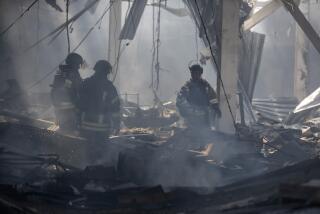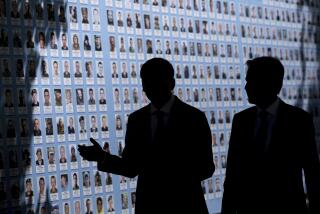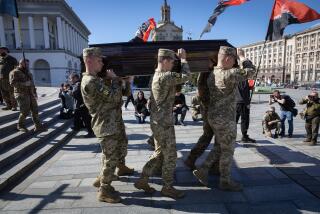Russian forces close in on Kyiv as fighting rages throughout Ukraine

Russia ramps up its invasion of Ukraine, President Biden prepares to confer with other world leaders and Ukrainians brace for war.
- Share via
KHARKIV, Ukraine — Russian troops appeared to be closing in on the Ukrainian capital of Kyiv on Friday as fighting continued throughout a country under increasing threat of being completely overrun by invading forces.
The sound of explosions before dawn was reported in Kyiv, as well as the wail of air-raid sirens and the staccato bursts of gunfire in several parts of the city. Ukraine’s military said that Russian spies and saboteurs were spotted about three miles north of the city center.
The Ukrainian Border Guard said on its Facebook page that Russian troops were in the northern suburb of Obolon and asked residents to report on their movements. It also urged them to “make Molotov cocktails, neutralize the occupier!”
Thousands of residents spent the night in subway stations for protection from potential bombs and airstrikes. Ukrainian President Volodymyr Zelensky gave a defiant video address calling on his compatriots not to flee, ordering men of fighting age, in particular, to stay.
“I remain in the capital. My family is also in Ukraine. My children are in Ukraine,” Zelensky said, adding that Russia had named him as “target No. 1 and my family as target No. 2.”
A senior Pentagon official said earlier that Moscow intends to topple Ukraine’s democratically elected government — presumably to install a friendly, subservient regime.
At least 137 Ukrainian civilians and military personnel have been killed and more than 300 wounded, Zelensky said. There were reports that 400 Russian forces had died, but Moscow has not issued a casualty count.
In the northeastern city of Kharkiv, Ukraine’s second-most populous, residents cautiously made their way around mostly empty streets amid a snowstorm Friday morning. Buses were still running. But just before noon, the sounds of explosions reverberated through the city center, sending pedestrians scurrying for shelter and motorists slamming on the gas in an attempt to escape from a threat they could hear but not see.
A channel on the messaging application Telegram posted a photo of what it said were the fins and fuselage of an unexploded missile lodged in a street in Kharkiv. The Times could not independently verify the image.
The violence came a day after Moscow accelerated its assault on neighboring Ukraine. On Thursday, explosions resounded in cities across the country, airstrikes crippled its defenses and Russian troops reportedly crossed into Ukraine by land and sea.
It was uncertain how long the Ukrainian army could hold back a blistering onslaught that included missiles, airborne units, heavy artillery and cyberattacks. But with brisk Russian offensives from the south, north and east, it appeared Russian President Vladimir Putin had his sights set on not just taking disputed regions of eastern Ukraine but also conquering a former Soviet republic turned U.S. ally and perceived threat to Moscow.
“We now have war in Europe on a scale and of a type we thought belonged to history,” said NATO Secretary-General Jens Stoltenberg.
Here in Kharkiv, scores of terrified residents sought refuge at an underground metro stop.
“I just can’t believe this is happening,” said Sergei, 38, a marketing manager, whose wife, mother and 4-year-old daughter sat on pink and blue yoga mats spread out on the platform. “This is the 21st century.”
All around him, bewildered Ukrainians threaded their way through crowds like extras in a film. “Not a World War II movie,” said Sergei, who, like others interviewed, declined to give his surname for safety reasons. “A horror movie.”
“They’re killing people and turning peaceful cities into military targets,” Zelensky said in a video address.
A woman reacts as she stands in front of a house burning after being shelled in the city of Irpin.
The turmoil has already displaced more than 100,000 people, the United Nations reported, as refugees began to trickle into neighboring nations, including Poland, Hungary and Romania.
The Russian invasion — with an estimated 190,000 troops massed around Ukraine — targeted strategic military sites and swept much of the nation. Russian missiles struck Ukrainian military command centers, air bases and depots in Kyiv and Kharkiv, as well as Dnipro, another major city, an advisor to Ukraine’s interior minister said on Facebook.
Russian forces took control of Chernobyl, the city north of Kyiv that was the site of the world’s worst nuclear accident, raising fears of a possible leak of radioactive material. Ukraine’s Interior Ministry also confirmed that Russian troops had seized a strategic international airport barely 10 miles outside Kyiv.
Many people in Europe are on edge as Russia mobilizes against Ukraine. Some fear a return to East-West divisions.
In Washington, President Biden described the onslaught as a “premeditated attack” that came “without provocation, without justification, without necessity.” He laid responsibility for it firmly on the Russian leader, calling the conflict “Putin’s war.”
Biden conferred with other world leaders Thursday to craft a response to an act of aggression that has drawn outcry across the globe and raised the specter of catastrophic bloodshed in Europe. Russia’s three lines of attack included an advance from the Crimean peninsula, a Russian bastion; and a thrust from northeastern Ukraine, a stronghold of pro-Russia separatists. A third advance of Russian military vehicles reportedly came from Belarus, a Russian ally, toward Kyiv, which lies barely 50 miles to the south.
Both the United States and the North Atlantic Treaty Organization moved to bolster the alliance’s military presence, though Biden said there was no plan for troops to become involved in Ukraine, which is not a NATO member. The Pentagon ordered the deployment to Germany of 7,000 additional service members in a move intended “to reassure NATO allies, deter Russian aggression and be prepared to support a range of requirements in the region.”
NATO also said it was sending additional land, air and maritime assets to its eastern flanks in a bid to enhance its ability to “respond to all contingencies.”
Civilians took shelter and lines formed at banks as people hastened to withdraw cash. Traffic jams snarled roads as residents tried to flee the capital. Ukrainian air traffic controllers sealed off the country’s airspace.
President Zelensky declared martial law and encouraged his compatriots to take up arms. Meanwhile, the U.S. and the West announced additional sanctions on Russia to isolate Russian banks, oligarchs and companies from world markets in response to an invasion that Moscow had long denied was planned, even as Washington insisted that an attack was imminent.
Putin portrayed the incursion — which followed months of Russian military buildup along Ukraine’s borders to the north, east and south — as a move to liberate and protect eastern Ukraine, where Moscow-backed secessionists hold sway over a large swath of the region. He warned other countries to not intervene, saying that it would lead to “consequences you have never seen in history.”
A woman reacts as she stands in front of a house burning after being shelled in the city of Irpin.
The invasion rattled Europe and stirred memories not only of the Cold War but also of World War II. It reflected Putin’s long mistrust of NATO and the West and his ambition to stitch back together remnants of the former Soviet Union. And it raised the specter of how the West — let alone Ukraine — would handle a likely humanitarian crisis while trying to counter a Russian military that possesses both conventional and nuclear weapons.
“This is a grave moment for the security of Europe,” said Stoltenberg, the NATO secretary-general, who will convene an emergency virtual summit of alliance leaders Friday. “Russia’s unjustified and unprovoked attack on Ukraine is putting countless innocent lives at risk.”
An advisor to Zelensky said Russian forces had seized Chernobyl, where a reactor exploded in April 1986, spewing radioactive materials across Europe. The stricken nuclear plant has since been decommissioned and the damaged reactor encased in a giant concrete-and-steel shelter, but Ukrainian authorities warned that fighting could damage the covering.
Putin announced his “special military operation” in eastern Ukraine in a nationally televised address early Thursday in Moscow. Even as he spoke, bombing runs began across Ukraine, with about two dozen strikes reported on major cities and other areas.
Breaking News
Get breaking news, investigations, analysis and more signature journalism from the Los Angeles Times in your inbox.
You may occasionally receive promotional content from the Los Angeles Times.
The Russian news agency Tass reported that Russian strikes “crippled” 74 Ukrainian military facilities, including 11 airfields, a navy base and 18 radar stations housing missile systems. All objectives “have been successfully fulfilled,” Defense Ministry spokesman Maj. Gen. Igor Konashenkov told reporters in Moscow.
The day before the incursion, Western powers said Russian soldiers had already entered Ukraine from the east, in the industrial heartland known as the Donbas, where Moscow’s proxy militias have engaged in battles with Ukrainian forces for eight years, costing thousands of lives. Putin on Monday recognized two Donbas enclaves under the control of pro-Russia separatists, Donetsk and Luhansk, as independent republics, setting the stage for him to send in troops to the region as “peacekeeping” forces.
Here in Kharkiv, Ukrainian soldiers stood in a field with two Howitzers aimed north, where the Russian border lay. A convoy of large Ukrainian military trucks lumbered down the road.
Almost all shops were closed. In the lobby of the high-end Kharkiv Palace Hotel, guests sipped coffee, wondering whether they should join the westward exodus.
“The Russians will be here in two hours,” said a man who gave his name as Anton, who had come to Kharkiv on a work trip and was trying to find a way to return to Kyiv. The road heading southwest to the city of Dnipro was not an option, he said, as he expected it to be bombed by the Russian military.
A full-scale Russian invasion of Ukraine appears imminent, but the two countries have for years been locked in cyber combat.
Some residents flocked to subway stations looking for escape or for shelter, lugging backpacks, small suitcases and pet carriers. Inside one station, people wedged themselves against the wall, using their bags to claim what little space they could as the crowds kept piling in. Those who could cram themselves into subway carriages did so, sitting on the seats, the floor or anywhere else they could find, waiting in darkness for the train service to start up.
Standing in the middle of a platform was Sergei, 30, a real estate agent turned programmer who was carrying his baby daughter, Naomi.
He wasn’t scared for himself, he said, but for Naomi. His wife, Katya, agreed, saying that they were trying to leave “not because we’re not patriots, but because we have a child. ... If it wasn’t for her I would go fight.”
As the day had worn on, the couple discussed whether they should try to get out of the city. There were no planes, no trains. Should they take a car and risk the traffic — not to mention the possibility of encountering Russian soldiers — on intercity roads?
“We just don’t know. There are too many rumors,” Katya said.
Earlier in the Donbas town of Slovyansk, about 75 miles north of Donetsk, the sound of explosions filled the morning air, but residents appeared to remain calm. As the sun rose, some emerged to start their workdays, albeit under tense circumstances.
“We’re going to stay open,” said Bogdan, an 18-year-old barista, as he slipped an almond croissant into a paper bag and handed it to a waiting customer at a cafe. “For now we’re waiting.”
Anton Chechenko, 30, an electric engineer who works in Slovyansk but whose family lives in Dnipro, about four hours’ drive to the west, stood in the central square and watched a flock of pigeons strut on cold tiles.
“Everyone here has lived through war. And we’re not seeing shelling yet,” he said. Besides, he added, “fear isn’t something that can save your life or your health. You need calm for that.”
The most visible sign at that hour of any distress was at banks and gas stations, where queues formed in the early morning and persisted as the day wore on. Alexander, 30, who gave only his first name, stood near a bank talking to an army officer on the street. He had just come back from the store and had loaded his backpack with canned food and other supplies.
He planned to go to a village near Kharkiv, to the northwest. “It will be calm there,” he said.
News Alerts
Get breaking news, investigations, analysis and more signature journalism from the Los Angeles Times in your inbox.
You may occasionally receive promotional content from the Los Angeles Times.
Shortly after he spoke, Zelensky announced that Ukraine was formally severing ties with Russia, which had earlier pulled out its diplomatic personnel from Kyiv, before the invasion began. Zelensky exhorted “those who have not yet lost their conscience” in Russia to go out and protest against the incursion.
“As of today, our countries are on different sides of world history,” Zelensky tweeted. “Russia has embarked on a path of evil, but Ukraine is defending itself and won’t give up its freedom.”
The assault negated weeks of frantic diplomacy to try to prevent war — and came even as the United Nations Security Council was in the midst of discussing the crisis in an extraordinary session.
It shatters a two-decade stretch of relative peace in Europe, which survived two world wars and a cold one in the 20th century. Even some seasoned analysts of contemporary Russia were stunned by Putin’s decision to move in, despite all the signs pointing to just such an intention.
The West is now under heavy pressure to present a united front not only in its rhetoric but also in the severity of penalties it is willing to inflict on Russia — and, as a consequence, on some of its own economies, particularly in Europe. Germany took a significant step toward that goal Tuesday when Chancellor Olaf Scholz announced that his government was halting authorization of the Nord Stream 2 pipeline project to bring Russian gas westward.
Much of Europe relies on Russian gas to heat homes and generate electricity. Russia supplies more than one-third of the gas consumed by the 27-nation European Union, making some member nations nervous about a major confrontation with Moscow.
The Biden administration says it has been working with European partners to secure other sources of energy for the Continent, although a rise in prices would be an inevitable result.
Bulos reported from Kharkiv, Chu from London and McDonnell from New York. Times staff writers Sarah D. Wire and Anumita Kaur in Washington contributed to this report.
More to Read
Sign up for Essential California
The most important California stories and recommendations in your inbox every morning.
You may occasionally receive promotional content from the Los Angeles Times.
